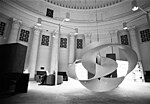Green Building (MIT)
1964 establishments in MassachusettsEmporis template using building IDI. M. Pei buildingsMassachusetts Institute of Technology buildingsSkyscrapers in Massachusetts ... and 2 more
University and college buildings completed in 1964Use mdy dates from May 2019

The Cecil and Ida Green Building, also called the Green Building or Building 54, is an academic and research building at the Massachusetts Institute of Technology (MIT) in Cambridge, Massachusetts. The building houses the Department of Earth, Atmospheric, and Planetary Sciences (EAPS). It is one of the tallest buildings in Cambridge. The Green Building was designed by I. M. Pei, who received a bachelor's degree in architecture from MIT in 1940, and Araldo Cossutta. Principal donor Cecil Howard Green received a bachelor's degree and master's degree from MIT and was a co-founder of Texas Instruments.
Excerpt from the Wikipedia article Green Building (MIT) (License: CC BY-SA 3.0, Authors, Images).Green Building (MIT)
McDermott Court, Cambridge
Geographical coordinates (GPS) Address External links Nearby Places Show on map
Geographical coordinates (GPS)
| Latitude | Longitude |
|---|---|
| N 42.360431 ° | E -71.089109 ° |
Address
54 Green Building (Building 54)
McDermott Court
02238 Cambridge
Massachusetts, United States
Open on Google Maps








